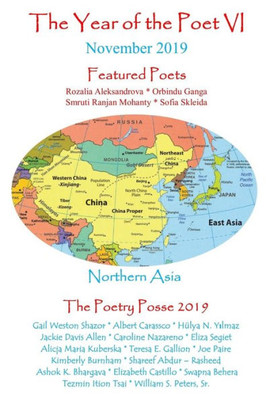
The Year Of The Poet Vi November 2019
inner child press, ltd.
ISBN13:
9781970020946
$15.78
ForewordThe definition of Northeast Asia is not static but often changes according to the context in which it is discussed.In common usage, the term Northeast Asia typically refers to a region including China. In this sense, the core countries constituting Northeast Asia are China, Japan, Taiwan, Mongolia, North Korea and South Korea.Broader definitions, such as that used by the World Bank refer to the "three major Northeast Asian economies, i.e. China, Japan, South Korea, and Taiwan", as well as Mongolia, North Korea, the Russian Far East and Siberia. The Council on Foreign Relations includes Mongolia and the Russian Far East. The World Bank also acknowledges the roles of sub-national or de facto states, such as Hong Kong and Macau. The Economic Research Institute for Northeast Asia defines the region as "China, Japan, the Koreas, Mongolia, and eastern regions of the Russian Federation".Despite not being culturally or ethnically East Asian, Russia is sometimes included in discussion as its political interests and policies clashes with those, in particular, of China, Japan, and the Koreas due to its control over the Russian Far East.The Yellow Sea, the Sea of Okhotsk, and the East China Sea are also included in discussions of the region.North East Asia is experiencing a large and growing ageing population. The pace of ageing is rapid due to declined fertility and increased longevity, and in some cases shrinking populations. The ageing population with the increasing old-age dependency ratio becomes one of the major challenges to the society, from socio-economic to policy systems. In recent years, North East Asia region is trying to identify technological solutions to assist older adults in independent living and social participation. The assistive technologies also contribute by reducing the burden on their families and caregivers.The past is haunting Northeast Asia. The China-Japan-Korea triad has been on a repeated collision course over how each perceives the shared past. Bound by dense memory webs, cultural affinity and geographical proximity, each of the three nations has made conflicting historical claims against the other, giving rise to conflict throughout the region and beyond.China, Japan, and Korea constitute the core of the Northeast Asian "community." "Community" which encompasses "religion, work, family, and culture; it refers to social bonds characterized by emotional cohesion, depth, continuity, and fullness." No community, however, can be totally unified; indeed, national communities can contain antagonistic elements, and the members of a community are not necessarily content with one another. The community of China, Japan, and Korea, like many a marriage, is charged with intense but coexisting feelings of interdependence and conflict, of love and hate.From a historical perspective, Greater Chinese culture remains the most important influence in this region. Although this statement will lead to opposition from nationalists in other countries. But the history of the origin and development can't be denied. As far as the author's cognition is concerned, since the Tang Dynasty, even earlier, Chinese culture has been deeply implanted in the hearts of all people in this region, whether in political, religious beliefs or lifestyle.Dr. Tzemin Ition Tsai
- | Author: The Poetry Posse, Inner Child Press Ltd.
- | Publisher: Inner Child Press, Ltd.
- | Publication Date: Oct 31, 2019
- | Number of Pages: 228 pages
- | Language: English
- | Binding: Paperback
- | ISBN-10: 1970020946
- | ISBN-13: 9781970020946
- Author:
- The Poetry Posse, Inner Child Press Ltd.
- Publisher:
- Inner Child Press, Ltd.
- Publication Date:
- Oct 31, 2019
- Number of pages:
- 228 pages
- Language:
- English
- Binding:
- Paperback
- ISBN-10:
- 1970020946
- ISBN-13:
- 9781970020946





